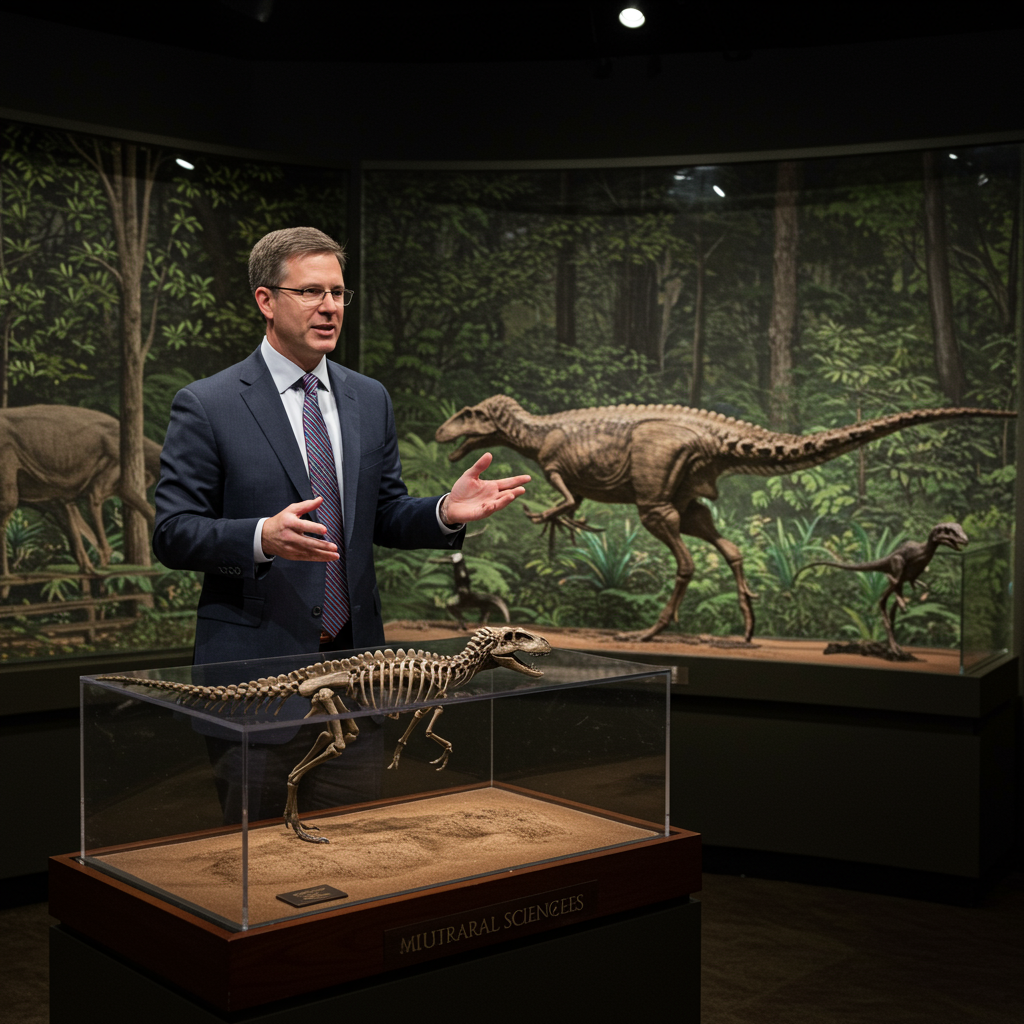Raleigh, NC — A groundbreaking scientific revelation is shaking the paleontology world, right here in North Carolina. What was long believed to be a juvenile Tyrannosaurus rex housed at the N.C. Museum of Natural Sciences has been definitively identified as a fully grown, distinct species: Nanotyrannus lancensis. This monumental discovery, hailed by Gov. Josh Stein as “the biggest dinosaur discovery of the decade,” not only puts North Carolina at the forefront of scientific research but also fundamentally redefines our understanding of prehistoric predators. Researchers, including those from NC State University, unveiled this stunning reclassification, sparking excitement among scientists and the public alike.
A Glimpse into the “Dueling Dinosaurs” Exhibit
At the heart of this transformative discovery lies the celebrated “Dueling Dinosaurs” exhibit, a cornerstone of the N.C. Museum of Natural Sciences’ DinoLab in downtown Raleigh. Since its impressive $6 million acquisition in 2020, the exhibit has captivated thousands of visitors annually. This colossal fossil, weighing an astonishing 20,000 pounds, required significant structural enhancements to the museum, including new steel reinforcements and the relocation of its lab to the first floor. Initially, the awe-inspiring display showcased a Triceratops locked in battle with what paleontologists thought was a teenage T-Rex, both unearthed together in Montana in 2006 and dating back approximately 67 million years. This dramatic scene set the stage for years of intense scientific scrutiny.
The Scientific Unmasking of Nanotyrannus
The journey to reclassify the predator specimen began with meticulous research conducted by a dedicated team, notably led by Dr. Lindsay Zanno, head of paleontology at the N.C. Museum of Natural Sciences and a professor at NC State University. For years, the scientific community debated whether smaller tyrannosaur fossils represented young T-Rexes or entirely separate species. The “Dueling Dinosaurs” specimen provided a unique opportunity to settle this long-standing argument. Researchers focused on the fossil’s growth rings within its bone structure, much like analyzing tree rings to determine age. This innovative method revealed a crucial insight.
Instead of showing the rapid growth expected of a T-Rex adolescent, the bone rings indicated a pattern of “slowed down and sped up with the seasons,” typical of a fully mature animal. This pivotal evidence confirmed the creature was not a rapidly growing teenager but a fully developed adult, estimated to be around 20 years old at its death. This scientific breakthrough, detailed in the prestigious journal Nature, officially established the predator as Nanotyrannus lancensis, a smaller, more lightweight relative of the iconic T-Rex, marking a significant advancement in paleontological understanding.
Why This Discovery Rewrites Dinosaur History
The identification of Nanotyrannus as a distinct species, rather than a juvenile T-Rex, carries profound implications for paleontology. Dr. Zanno emphasized that this finding “doesn’t just settle the debate” but “flips decades of T. rex research on its head.” Many previous studies on T-Rex growth and development may have inadvertently incorporated data from Nanotyrannus specimens, mistakenly assuming they were young T-Rexes. This reclassification demands a re-evaluation of existing theories about how T-Rex grew and evolved, offering a clearer picture of the diverse tyrannosaur ecosystem during the late Cretaceous period.
Furthermore, the discovery highlights the fascinating coexistence of distinct tyrannosaur species in their final prehistoric days before the mass extinction event. Understanding the ecological niches occupied by both T-Rex and Nanotyrannus provides invaluable insights into the complex food webs and competitive dynamics of these ancient landscapes. Gov. Josh Stein rightly lauded the discovery, stating, “This is the biggest dinosaur discovery of the decade, and I am proud that it is happening right here in North Carolina,” underscoring the state’s vital role in global scientific advancement and research.
Witness Science in Action at the DinoLab
One of the most remarkable aspects of this discovery is its accessibility to the public. The N.C. Museum of Natural Sciences is uniquely designed to foster public engagement with science. Its DinoLab, located at the museum’s entrance facing Jones Street (an avenue more famously known for the N.C. Legislative Building), offers visitors an unparalleled opportunity. Here, behind large glass windows, museum paleontologists conduct their ongoing research in full view of the public.
Visitors can not only observe scientists at work on the magnificent “Dueling Dinosaurs” fossil but also engage directly with the research team. This transparent approach to scientific inquiry makes complex paleontology accessible and exciting, transforming museum visits into immersive educational experiences. The museum, a part of the state government complex, continues to serve as a beacon of scientific exploration, showcasing the dedication of institutions like NC State University and the N.C. Museum of Natural Sciences to continuous scientific research and advancement.
North Carolina’s Enduring Scientific Legacy
The announcement of the Nanotyrannus discovery reinforces North Carolina’s burgeoning reputation as a hub for scientific excellence. Governor Stein’s praise for the state’s public universities and museums underscores their commitment to being “continuously on the forefront of scientific research and advancement.” This discovery is a testament to the collaborative spirit and cutting-edge facilities available within the state.
The public’s ability to engage directly with ongoing research, coupled with the museum’s significant investment in acquiring such a pivotal fossil, creates a powerful ecosystem for scientific discovery and education. It’s a reminder that truly groundbreaking work doesn’t always happen behind closed doors; sometimes, it unfolds right before our eyes, inspiring the next generation of scientists and curious minds.
Frequently Asked Questions
What exactly is Nanotyrannus and how was it identified?
Nanotyrannus lancensis is now recognized as a distinct, fully grown species of tyrannosaur, a smaller and more lightweight relative of the formidable Tyrannosaurus rex. It was identified through meticulous analysis of growth rings within its fossilized bones, similar to how age is determined from tree rings. Researchers, including Dr. Lindsay Zanno, found that the bone growth patterns indicated a slowing and speeding with seasons, characteristic of an adult animal, not the rapid growth expected in a juvenile T-Rex. This confirmed it was a mature creature, estimated to be around 20 years old, distinguishing it from a young T-Rex and solidifying its status as a separate species.
Where can the public see the Nanotyrannus fossil and witness ongoing research?
The public can view the Nanotyrannus fossil, part of the “Dueling Dinosaurs” exhibit, at the N.C. Museum of Natural Sciences in downtown Raleigh, NC. The museum’s unique DinoLab features a publicly accessible research space where paleontologists actively work on the fossil. Visitors can observe the scientific process firsthand and even interact with the research team. The museum, known for its giant two-story globe, is located on Jones Street and offers an immersive experience into the world of paleontology and this groundbreaking discovery.
Why is the Nanotyrannus discovery considered “the biggest of the decade” for paleontology?
This discovery is monumental because it fundamentally redefines our understanding of tyrannosaur evolution and the ecosystem of the late Cretaceous period. By confirming Nanotyrannus as a distinct species rather than a juvenile T-Rex, it necessitates a re-evaluation of decades of T-Rex growth studies, which may have mistakenly included Nanotyrannus data. This separation clarifies the diversity of tyrannosaur species coexisting and offers new insights into their ecological roles. Governor Josh Stein’s endorsement underscores its significance, placing North Carolina at the forefront of global scientific breakthroughs and enhancing our knowledge of prehistoric life.
A New Chapter in Prehistoric History
The reclassification of the “Dueling Dinosaurs” predator as Nanotyrannus lancensis marks a pivotal moment in paleontology and a point of immense pride for North Carolina. This isn’t just a local story; it’s a global scientific headline that challenges long-held assumptions and opens new avenues for research into Earth’s ancient past. From the dedicated scientists at the N.C. Museum of Natural Sciences and NC State University to the engaging public spaces that allow everyone to be a part of the discovery, North Carolina continues to prove its commitment to advancing human knowledge. We invite you to visit the museum, witness this incredible fossil, and engage with the science that continues to unfold right before our eyes.




